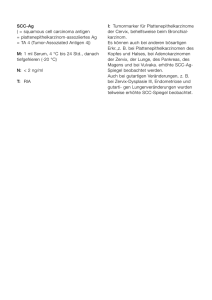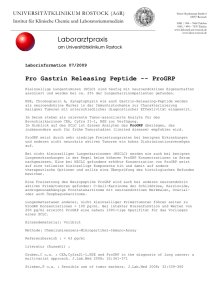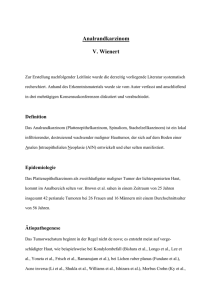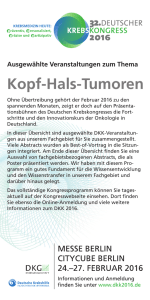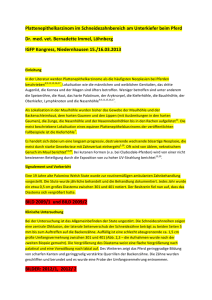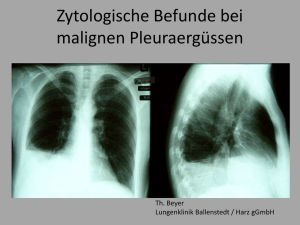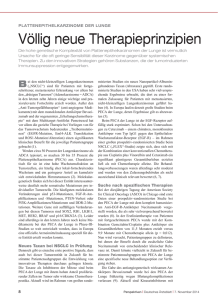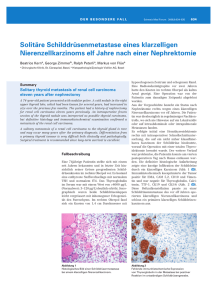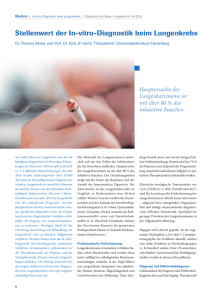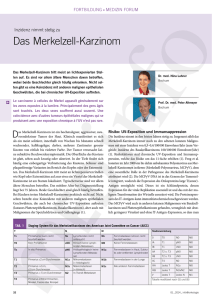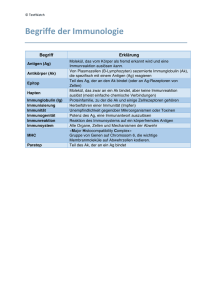Unterstützung im Management von Patienten mit
Werbung
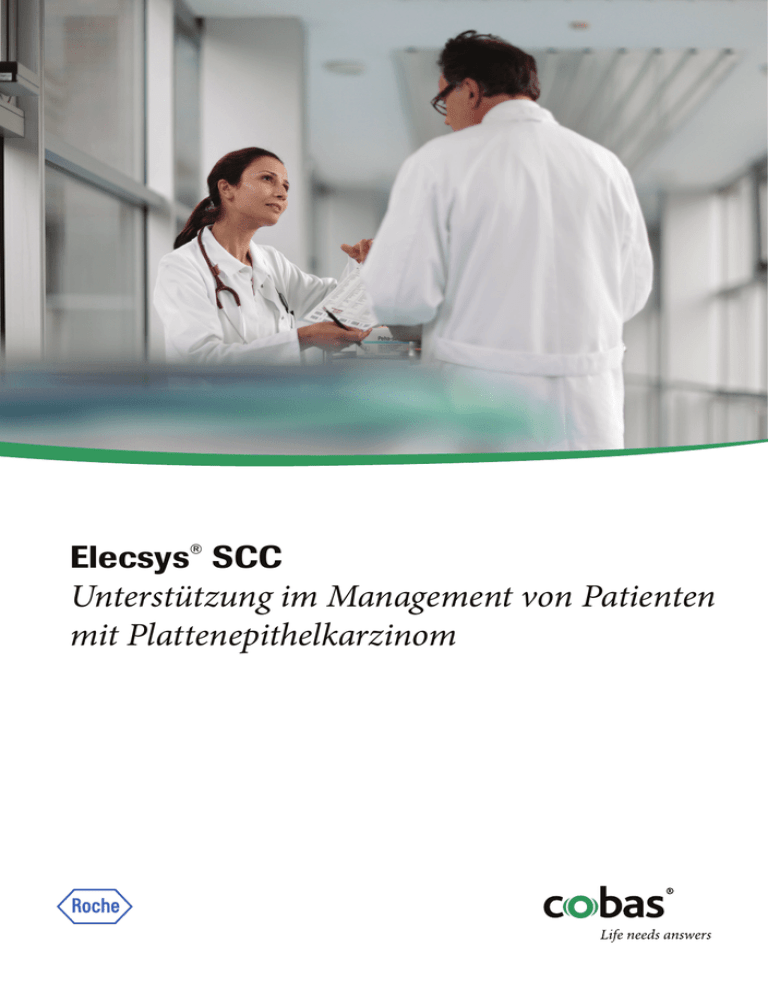
ElecsysT SCC Unterstützung im Management von Patienten mit Plattenepithelkarzinom ElecsysT SCC Unterstützung im Management von Patienten mit Plattenepithelkarzinom Das SCC-Antigen (squamous cell carcinoma antigen) wurde im Zusammenhang mit kleinzelligen Tumoren einschliesslich Lungen-, Gebärmutterhals-, Speiseröhren- sowie Kopf- und Halstumoren untersucht.1,2,3 Je fortgeschrittener das Erkrankungsstadium, desto höhere SCC-Antigen-Spiegel lagen vor, besonders bei Lungen- und Gebärmutterhalskrebs. Einen weiteren Anwendungszweck stellt die Unterstützung der Beurteilung von Rezidiv, der Resterkrankung nach der Behandlung sowie des Therapieerfolgs dar.4,5,6 Breites Tumormarker-Portfolio für effizientes Patientenmanagement • Laborgesamtlösung für die Bestimmung der Lungenkrebs-Biomarker SCC, ProGRP, NSE, Cyfra 21-1 und CEA aus einem einzigen Probenentnahmeröhrchen. • Das SCC-Antigen als Biomarker für Gebärmutterhalskrebs ist mit anderen Biomarkern für gynäkologische Tumore (CA 125, HE4, CA15-3, HPV, CINtec T PLUS etc.) ein zusätzliches Instrument für das Patientenmanagement. Roche Diagnostics (Schweiz) AG Industriestrasse 7 6343 Rotkreuz www.roche-diagnostics.ch www.cobas.ch CINTEC, COBAS, ELECSYS und LIFE NEEDS ANSWERS sind Marken von Roche. © 2016 Roche Diagnostics. Alle Rechte vorbehalten. ➀ 0216 > 2 ng/ml < 1,5 ng/ml NSCLC ProGRP > 100 pg/ml und NSE > 30 pg/ml SCLC < 2 ng/ml Stadium I-III (intrathorakal) Stadium IV (extrathorakal) ProGRP <100 pg/ml ProGRP >150 pg/ml ProGRP >200 pg/ml ProGRP <200 pg/ml und und und und NSE < 30 ng/ml NSE > 35 ng/ml NSE > 45 ng/ml NSE < 45 ng/ml und CYFRA > 3,3 ng/ml und CYFRA > 4,9 ng/ml oder CEA > 5 ng/ml oder CEA > 8 ng/ml oder SCCA 1,5– 2 ng/ml oder SCCA 1,5– 2 ng/ml NSCLC SCLC SCLC NSCLC Abb. 1: Algorithmus zur Verwendung von Biomarkern bei Lungenkrebs zur Bestimmung des histologischen Subtyps; SCLC = Kleinzelliges Lungenkarzinom 9 300 N= 60 N=127 300 100 30 10 3 1 30 10 3 1 0,3 0,3 0,1 0,1 Benigne Gebärmuttergynäkologische hals-PlattenErkrankungen epithelkarzinom Abb. 2a: SCC-Antigen – Werte bei Ge-bärmutterhalskarzinom und benignen gynäkologischen Erkrankungen N=31 N=45 N=34 N=16 100 SCC [ng/ml] ECL-Technologie liefert herausragende SCC-TestPerformance •Detektion von SCC-Antigen 1 und 2, welche eine wichtige Rolle bei Plattenepithelkarzinomen spielen.13 •Höchste Präzision für ein genaues und nachhaltiges Patientenmonitoring. SCC-Antigen (SCCA) SCC [ng/ml] Marker der Wahl bei Platten­e pithelkarzinomen Nichtkleinzelliges Lungenkarzinom (NSCLC) •Das SCC-Antigen (SCCA) ist ein nützlicher Biomarker für NSCLC, vor allem für den Typ Plattenepithelkarzinom. •Es kann ein Indikator für Rezidiv, Resterkrankung sowie den Therapieerfolg sein.7,8 •Das SCC-Antigen wurde als Teil eines Biomarker-Panels zur Indikation von histologischen Subtypen9 (Abb. 1) sowie zur Risikobeurteilung für Lungenkrebs beschrieben.10 Gebärmutterhalskrebs •Gute Differenzierung zwischen Plattenepithelkarzinom des Gebärmutterhalses und benignen gynäkologischen Erkrankungen mit eindeutiger Korrelation zwischen den SCC-Antigen-Werten und dem UICC-Stadium11 (Abb. 2a und 2b). Kopf- und Halstumore •Bei 90 % der Kopf- und Halstumore handelt es sich um Plattenepithelkarzinome. Bei Patienten mit Lymphknoten­befall wurden signifikant höhere SCCA-Spiegel beobachtet.12 I II III IV Stadium nach UICC Abb. 2b: Korrelation der SCCAntigen-Werte mit dem Stadium nach UICC Literatur 1 Sandri, M.T. et al. (2013). Detection of squamous cell carcinoma antigen with two systems in the follow-up of patients with cervical cancer. Int. J. Biol. Markers; 28: 313-317. 2 Torre, G.C. (1998). SCC antigen in malignant and nonmalignant squamous lesions. Tumor Biol; 19: 517-26. 3 Kato, H. et al. (1977). Radioimmunoassay for Tumor Antigen of Human Cervical Squamous Cell Carcinoma. Cancer; 40: 1621-8. 4 Kato, H., Morioka, H., Aramaki, S. and Torigoe, T. (1979). Radioimmunoassay for Tumor-Antigen of Human Cervical Squamous Cell Carcinoma. Cell. Mol. Biol.; 25: 51-56. 5 Cataltepe, S., Gornstein, E.R., Schick, C. et al. (2000). Co-expression of the squamous cell carcinoma antigens 1 and 2 in normal adult human tissues and squamous cell carcinomas. J Histochem. Cytochem.; 48: 113-122. 6 Schneider, S.S., Schick, C., Fish, K.E. et al. (1995). A serine proteinase inhibitor locus at 18q21.3 contains a tandem duplication of the human squamous cell carcinoma antigen gene. Proc. Natl. Acad. Sci. USA; 92: 3147-31451. 7 Roijer, E., Kosinska, U., Andersson, I., Nilsson, K., Nilsson, O. (2003). Rearrangement of Squamous cell Carcinoma antigen genes. Detection of SCCA fusion transcripts. Tumor Biol.; 24: 46-52. 8 Schick, C., Bromme, D., Batuski, A.J. et al. (1998). The reactive site loop of the serpin SCCA1 is essential for cysteine proteinase inhibition. Proc Natl Acad Sci USA; 95: 13465-13470. 9 Molina, R. (2009). ProGRP: A new biomarker for small cell lung cancer. EJCMO; 1: 25-32. 10 Molina, R. et al. (2015). Assessment of a combined panel of six serum tumor markers for lung cancer. Am. J. Resp. Crit. Care Med.; in press. 11 Roche report Elecsys SCC multicenter evaluation. 12 Molina, R., Torres, M.D., Moragas, M., Perez-Villa, J., Filella, X., Jo, J., Farrus, B., Giménez, N., Traserra, J., Ballesta, A.M. (1996). Prognostic significance of SCC antigen in the serum of patients with head and neck cancer. Tumor Biol.; 17: 81-90. 13 Kato, et al. (1984). Jpn. J. Cancer Res.; 75: 433-435.
